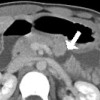Isolated Pediatric Pancreatic Transection Secondary to Ocean-Related Trauma
Abstract
Context Isolated pancreatic transection is a rare but well-recognized complication following blunt trauma of the abdomen. Diagnosis at presentation may be difficult and delayed due to subtle initial symptoms and evolving nature of the injury. Case report We describe an isolated complete pancreatic transection in a 14-year-old female secondary to a previously unreported and highly unusual mechanism (being tossed by a wave). Diagnosis was obtained by computed tomography scan 24 hours following initial trauma. She was managed operatively with an open distal pancreatectomy with splenic preservation and no subsequent complications. Conclusions The force sustained from the blunt abdominal trauma of being tossed by a wave can be significant. The management of pancreatic injuries in children, particularly in the context of ductal transection, is controversial. Timely recognition and management is critical to optimal outcomes. Early operative intervention may help to avoid complications such as abscess or pseudocyst formation.
Image: CT scan of the abdomen demonstrating complete transection of the pancreas.
Downloads
References
Moore EE, Cogbill TH, Malangoni MA, et al. Organ injury scaling, II: Pancreas, duodenum, small bowel, colon, and rectum. J Trauma 1990;30:1427-9. [PMID 2231822].
Wales PW, Shuckett B, Kim PC. Long-term outcome after nonoperative management of complete traumatic pancreatic transection in children. J Pediatr Surg 2001;36:823-7. [PMID 11329598].
Herman R, Guire KE, Burd RS, et al. Utility of amylase and lipase as predictors of grade of injury or outcomes in pediatric patients with pancreatic trauma. J Pediatr Surg 2011;46:923-6. [PMID 21616253].
Meier DE, Coln CD, Hicks BA, Guzzetta PC. Early operation in children with pancreas transection. J Pediatr Surg 2001;36:341-4. [PMID 11172430].
Smith DR, Stanley RJ, Rue LW, 3rd. Delayed diagnosis of pancreatic transection after blunt abdominal trauma. J Trauma 1996;40:1009-13. [PMID 8656454].
Jobst MA, Canty TG, Sr., Lynch FP. Management of pancreatic injury in pediatric blunt abdominal trauma. J Pediatr Surg 1999;34:818-23; discussion 23-4. [PMID 10359187].
Bosboom D, Braam AW, Blickman JG, Wijnen RM. The role of imaging studies in pancreatic injury due to blunt abdominal trauma in children. Eur J Radiol 2006;59:3-7. [PMID 16781837].
Sivit CJ, Eichelberger MR, Taylor GA, et al. Blunt pancreatic trauma in children: CT diagnosis. AJR Am J Roentgenol 1992;158:1097-100. [PMID 1566674].
Nikfarjam M, Rosen M, Ponsky T. Early management of traumatic pancreatic transection by spleen-preserving laparoscopic distal pancreatectomy. J Pediatr Surg 2009;44:455-8. [PMID 19231557].
Mattix KD, Tataria M, Holmes J, et al. Pediatric pancreatic trauma: predictors of nonoperative management failure and associated outcomes. J Pediatr Surg 2007;42:340-4. [PMID 17270545].
Adamson WT, Hebra A, Thomas PB, et al. Serum amylase and lipase alone are not cost-effective screening methods for pediatric pancreatic trauma. J Pediatr Surg 2003;38:354-7; discussion -7. [PMID 12632348].
Nadler EP, Gardner M, Schall LC, et al. Management of blunt pancreatic injury in children. J Trauma 1999;47:1098-103. [PMID 10608540].
Matsuno WC, Huang CJ, Garcia NM, et al. Amylase and lipase measurements in paediatric patients with traumatic pancreatic injuries. Injury 2009;40:66-71. [PMID 19135195].
Paul MD, Mooney DP. The management of pancreatic injuries in children: operate or observe. J Pediatr Surg 2011;46:1140-3. [PMID 21683212].
Levine RA, Bank MA. Traumatic transection of the pancreas. A case of delayed presentation. JOP 2011;12:47-9. [PMID 21206102].
Wood JH, Partrick DA, Bruny JL, et al. Operative vs nonoperative management of blunt pancreatic trauma in children. J Pediatr Surg 2010;45:401-6. [PMID 20152361].
Reynolds EM, Curnow AJ. Laparoscopic distal pancreatectomy for traumatic pancreatic transection. J Pediatr Surg 2003;38:E7-9. [PMID 14577094].
Iqbal CW, Levy SM, Tsao K, et al. Laparoscopic versus open distal pancreatectomy in the management of traumatic pancreatic disruption. J Laparoendosc Adv Surg Tech A 2012;22:595-8. [PMID 22691182].
Rutkoski JD, Segura BJ, Kane TD. Experience with totally laparoscopic distal pancreatectomy with splenic preservation for pediatric trauma--2 techniques. J Pediatr Surg 2011;46:588-93. [PMID 21376217].
Knaebel HP, Diener MK, Wente MN, et al. Systematic review and meta-analysis of technique for closure of the pancreatic remnant after distal pancreatectomy. Br J Surg 2005;92:539-46. [PMID 15852419].
Healey AJ, Dimarikis I, Pai M, Jiao LR. Delayed presentation of isolated complete pancreatic transection as a result of sport-related blunt trauma to the abdomen. Case Rep Gastroenterol 2008;2:22-6. [PMID 21490833].
Martinez-Ramos D, Cifrian-Perez M, Garcia-Vila JH, et al. Percutaneous drainage treatment of traumatic pancreatic rupture with pancreatic transection. Gastroenterol Hepatol 2010;33:102-5. [PMID 19896241].
Buchta RM. A ruptured spleen due to body surfing. J Adolesc Health Care 1981;1:317-8. [PMID 7333936].

Copyright (c) 2014 Afif N Kulaylat, Danielle M Pastor, Mary C Santos

This work is licensed under a Creative Commons Attribution 4.0 International License.
As a member of Publisher International Linking Association, PILA, iMedPub Group’s JOP follows the Creative Commons Attribution License and Scholars Open Access publishing policies. Journal of the Pancreas is the Council Contributor Member of Council of Science Editors (CSE) and following the CSE slogan Education, Ethics, and Evidence for Editors.